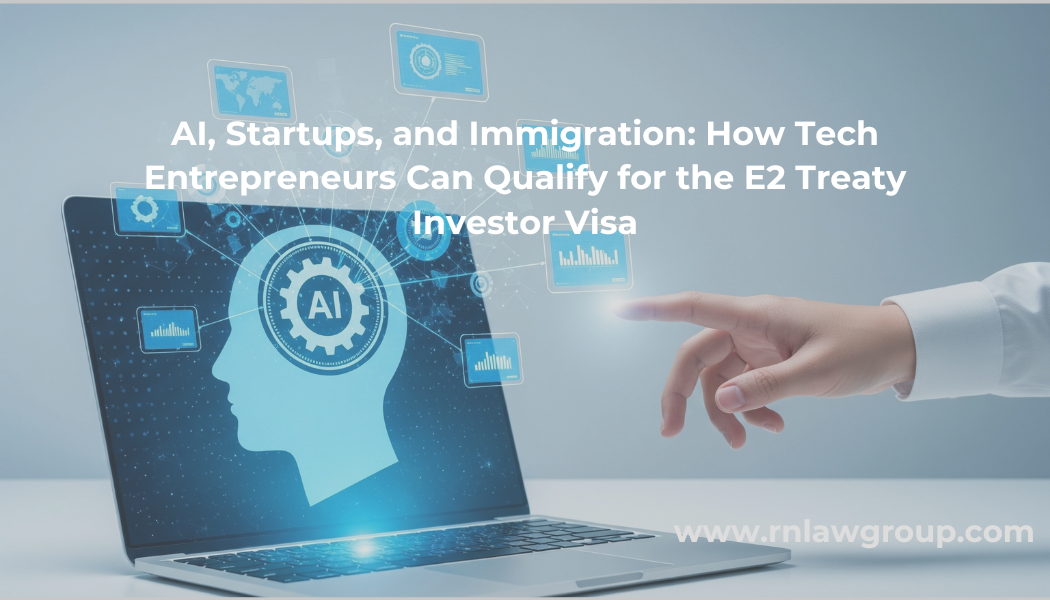
AI, Startups, and Immigration: How Tech Entrepreneurs Can Qualify for the E 2 Treaty Investor Visa
In the fast-moving world of technology startups and artificial intelligence, many entrepreneurs look to base their operations in the United States. For founders from treaty-countries, the E-2 visa can be a strong business-immigration strategy. This article breaks down how tech entrepreneurs, particularly those working in AI and startups, can leverage the E-2 pathway, what to watch out for, and strategic tips to improve a successful outcome.
What is the E-2 visa?
The E-2 visa (formally the “Treaty Investor” classification) allows nationals of countries with which the U.S. maintains a treaty of commerce and navigation to come to the U.S. to invest in, develop and direct a bona fide enterprise.
- The applicant must be a national of a treaty country.
- The investor either has already invested or is in the process of investing a “substantial amount of capital” in a U.S. enterprise.
- The investor must enter the U.S. with the purpose of developing and directing the enterprise. Usually this means more than a silent passive investor.
- The business must be “real and operating” (not merely a shell) and not marginal (i.e., must have the capacity to generate more than just supporting the investor’s personal living).
- There is no fixed minimum investment amount set in law; rather, the investment must be substantial in proportion to the total cost of the business.
- The investor must show the funds are at risk (i.e., committed/invested) and that the source is lawful.
- The E-2 is a non-immigrant classification: there is generally an expectation of returning home when the status ends, although extensions are possible.
For tech startup founders, the appeal is clear: you can come to the U.S., lead your company, operate in the innovation ecosystem, and retain flexibility.
Why E-2 makes sense for AI/startup founders
Here are several reasons the E-2 can be particularly suitable for tech entrepreneurs:
- Speed and flexibility: Compared to many other immigration pathways (especially immigrant visas), the E-2 can move relatively quickly and is renewable as long as the business continues to operate.
- Control: The founder retains operational control (or majority ownership) of the enterprise, which aligns with a startup founder’s desire to lead product, team, and strategy.
- Scalable business model: Tech startups , particularly AI-enabled ventures, often seek rapid growth, job creation, and may satisfy the “real and operating enterprise” requirement without needing huge physical infrastructure.
- Dependent family benefits: The founder’s spouse and children (under 21) can typically accompany and, in many cases, the spouse may be eligible for work authorization.
- No fixed investment minimum: While the investment still must be substantial, the lack of a fixed threshold allows more flexibility , especially for tech startups whose major costs may be R&D, team, technology rather than heavy bricks-and‐mortar.
Key challenges and “gotchas” for tech founders
Before moving ahead, founders should keep these common pitfalls in mind:
- Nationality requirement: If the founder is not a national of a treaty country, E-2 is not available. For example, nationals of countries that don’t have a qualifying treaty are excluded.
- Business must be more than marginal: A startup plan that does not reasonably show more than minimal economic impact (job creation or revenue) may face a challenge. For example, if the business is only enough to support the founder personally, that is not sufficient.
- Funds must be “at risk” and committed: Simply depositing money into an account may not suffice; the founder should show the investment is irrevocably committed and subject to loss.
- Business must be real, active, and viable: For tech startups this means you must show evidence of activity (incorporation, bank accounts, contracts, product development, paying staff) not just an idea.
- Non-immigrant intent issues: Because the E-2 is non-immigrant in nature, there must be at least an expressed intent to depart when status ends, not necessarily an intent to remain permanently. Some founders worry about long-term permanence
- Startup risk vs. investment risk: In tech, many founders focus on growth and pivot rather than stable profitability. Immigration officers will still expect the investment to be placed at risk and a meaningful enterprise to be underway.
- Renewals and scaling: While renewals are possible, the business must continue to meet the requirements. If growth stalls or no jobs are created, renewals may be harder.
Strategic roadmap for tech founders targeting E-2
Below is a suggested roadmap tailored to AI or tech startup founders who plan to use E-2 as part of their immigration strategy:
- Confirm treaty-country eligibility
Check that you hold citizenship of a country that has a qualifying treaty with the U.S. Travel.gov If not, evaluate whether you hold or can obtain citizenship of a treaty country (some founders hold dual citizenship).
- Form your U.S. entity and set up operations
- Incorporate a U.S. company (LLC, corporation, etc.) and open a U.S. business bank account.
- Document that your company is a bona fide enterprise: you should have a business plan, contracts, website, client pipeline, hiring plan or actual hires.
- For tech/AI: Show you are hiring U.S. staff, paying wages, acquiring or developing IP, or engaging in commercialization.
- Invest capital and begin placing it “at risk”
- Transfer the investment funds into the U.S. business account, and begin expending them (e.g., salaries, equipment, marketing, product development).
- Maintain clear documentation of the source of funds (sale of property, savings, lawful earnings) and proof of transfer.
- Decide on how “substantial” your investment is in context: for a tech company, you might show spending in the $65,000-$300,000 or more range depending on business model.
- Demonstrate business viability, job creation and operational control
- Show you own at least 50% of the enterprise or otherwise control its operations.
- Show that your business is not marginal: e.g., you have or will have U.S. employees, you are generating or projecting meaningful revenues, or you serve the U.S. market. For a tech startup, you may show a hiring plan, product launch timeline, revenue projections, or clients secured.
- Emphasize that you are developing and directing the enterprise, not merely investing passively.
- File your E-2 application (either consular or change of status)
- If you are outside the U.S., you will generally apply at the U.S. consulate in your home country (or U.S. consular post) for the E-2 visa.
- If you are already in the U.S. in another status, you might file Form I-129 for a change of status to E-2.
- Prepare heavily documented business plan, financials, proof of investment, proof of nationality, entity incorporation documents, contracts, staffing, etc.
- Be ready to explain your business model, your role as founder, and how the enterprise will impact the U.S. economy.
- In interviews, you may be asked about your intention, how the enterprise will operate, risk of funds, business timeline etc.
- Once approved: Operating and scaling
- After arrival as an E-2 investor, run the business actively: hire staff, develop product, secure clients, grow revenues.
- Track and document your operations: payroll, bank statements, contracts, marketing efforts, growth metrics.
- For renewals: Be ready to show the business continues to meet the “real and operating” and “not marginal” standards.
- Consider exit or scaling options: If your business grows substantially, you might later evaluate other visa categories or paths to permanent residency.
Special considerations for AI & tech-focused startups
- IP and innovation: Highlight your tech/AI product or service, show market traction, potential for revenue growth, and how investment supports that. Immigration officers may appreciate concrete data (beta launch, pilot clients, partnerships).
- Remote/hybrid workforce: Since tech companies often use distributed teams, document U.S. engagement: U.S. clients, U.S. employees or contractors, U.S. operations base, U.S. marketing.
- Scalability and job creation: Even if you start lean, show a credible roadmap for hiring or other U.S. economic impact.
- Funding rounds or venture backing: If your startup has raised U.S. investor funding or is participating in an accelerator/incubator, that can show viability and risk. While E-2 doesn’t require a set job-creation number, strong evidence helps.
- Business model clarity: Immigration adjudicators will look for a clear business model (especially for “real and operating” enterprise). Tech founders should describe how they generate revenue, what their product is, who their customers are.
- Exit risk: The “at risk” investment requirement means you must show your funds are committed and subject to loss if things don’t work out. For a tech startup this might mean you have actually transferred money, entered contracts, hired staff, etc., rather than just planning to do so.
Conclusion
For tech-savvy startup founders from treaty countries, the E-2 visa presents a compelling path: you can invest and lead your U.S. business, tap into the U.S. innovation ecosystem, bring your family, and build your vision. But success depends on doing the groundwork: forming the business correctly, investing and documenting the investment risk, showing operational control and business viability, and meeting the real and non-marginal enterprise requirements.
If you’re working on building an AI or tech startup and want to “plant” it in the U.S., the E-2 deserves serious consideration , but it’s not plug-and-play. Careful planning, documentation, and a realistic business plan are key.
By: Felipe Jimenez
Felipe Jimenez is an Associate Attorney at Reddy Neumann Brown PC. He works in the Non-Immigrant Visa (NIV) Department where he assists clients through all phases of the non-immigrant visa process.
Reddy Neumann Brown PC has been serving the business community for over 20 years and is Houston’s largest immigration law firm focused solely on US. Employment-based immigration. We work with both employers and their employees, helping them navigate the immigration process quickly and cost-effectively.

